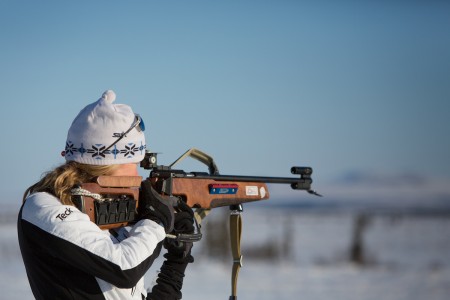
Note: a quick read of Alex Matthews’ piece on NANANordic, published yesterday, will be helpful but not essential background.
Anyone familiar with the NANANordic project – whether from a friend who has participated, reading about it online, or glimpsing tantalizing Facebook photos of skiing in the Arctic – will find Zach Hall’s account of how he got involved pretty familiar.
“Lars (Flora) posted on Facebook that he was looking for volunteers to coach in the Arctic… and I jumped on the chance,” Hall, an Anchorage-based former U.S. national team biathlete, told FasterSkier.
That’s the usual way the story starts: excitement at the chance to give something back while also getting something in return: a glimpse of a part of America that most people might go their whole lives never thinking about. The largest of the northwestern Alaskan region’s eleven villages has a population of roughly 3,000, a number that sounds tiny to city-dwellers and suburbanites alike; one that’s 1,800 miles from the northern border of the contiguous 48? It’s not a trip that many get to make.
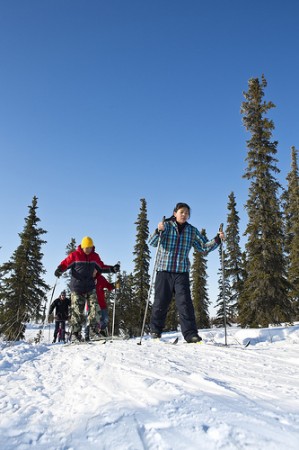
Then, the adventure begins, and those feelings only get stronger as athletes work with students who have zero background in skiing, a different view of the world, and seemingly boundless enthusiasm.
“There’s something about being involved in a program that is launched and sustained by passionate people,” Hall said of his experience last year. “All the volunteer coaches were psyched to be there and the excitement was palpable from the students. I’ve been blessed throughout my ski career with so many people that invested time and energy into my development, and it’s fun and rewarding to be in a position to begin passing that on.”
As it happened, Hall’s biathlon skills gave him an extra opportunity to pass it on, something that Flora quickly picked up on. He asked Hall and his girlfriend, current national-teamer Sara Studebaker, to bring their rifles along and introduce the kids in the village of Kiana to biathlon last year.
It was such a success that Hall, who coaches a few juniors in the Anchorage area, took on the challenge of organizing a broader biathlon program for this year. From recruiting to logistics, he was in charge of getting biathletes to six different communities in the region.
A Different Biathlon Introduction
There’s a lot of reasons that Flora thought biathlon would be a good fit for the program.
“The patience and focus needed to participate in biathlon is amazing,” Flora, an Olympic cross-country skier, told FasterSkier. “In addition, the time needed to learn about gun safety, and practicing marksmanship are extremely valuable for students and skiers.”
But as Hall, Studebaker, and Flora learned when the biathletes demoed their sport in a single village last year, there are many more reasons that it was an excellent choice for the program. Unlike most people who are introduced to the sport through nordic skiing, the villagers could see real practical use in the combination of skiing and shooting. Furthermore, biathlon, which in modern times is a military sport, actually has its roots in their type of lifestyle.
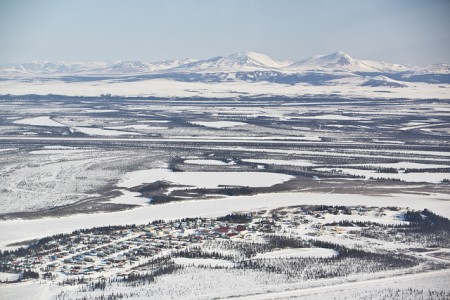
“I would tell a story about the history of biathlon, tie in how peoples of the north have hunted on some form of ski for thousands of years and then describe the development of this most practical hunting method into one of the most popular winter Olympic sports,” Hall said.
And the kids got the message; coach Susan Dunklee said that after a demonstration, there was always a group that wanted to hang around and talk with her about hunting.
“The hunting link isn’t too hard to make for the kids since it’s such a way of life for them,” said Hall. “It’s convenient for villagers when the caribou pass near the village, but that’s not always the case. At over $10 a gallon, the price of fuel can make hunting on a snow machine cost prohibitive, so I also tried to get kids to think about skiing as a means of transportation that is economical and sustainable.”
So the participants definitely “got” the first part of Hall’s message. But the part about how this activity, old and necessary, transformed into a sport where each race broadcast on television is watched by over 15 million people?
They got that, too.
“We had several kids that told us they want to go to the Olympics as skiers,” Hall said.
Nuts and Bolts
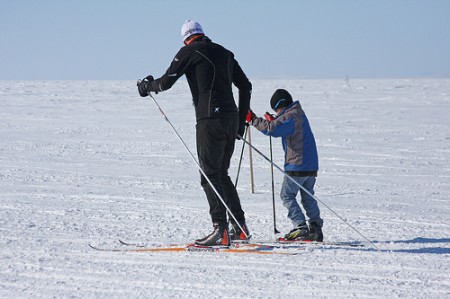
Besides looking at the big, inspirational and aspirational picture, Hall had to get down to the gritty details, too: how do you teach hundreds of kids a sport that involves an unfamiliar endurance component, as well as a firearm component with all of its associated safety headaches?
The biggest lesson from his first year with NANANordic is that there’s no single by-the-book way to teach biathlon to the kids.
“It’s important to be really flexible with the programming, so for this year the we wanted to get biathletes into a few more of the villages and then provide a framework for how to present biathlon but to ultimately leave it up to them to respond to the interest levels of the students as well as the climate of each village,” he said.
As such, he and Flora, along with school administrators in the villages, decided that no bullets would be fired. That’s right: biathlon without bullets. They would get the participants familiar with the sport and the guns, and in future years incorporate actual shooting instruction (the kids were certainly clamoring for it). Flora reported that he and Hall are working on getting more rifles to use next year.
Meanwhile, athletes in the six villages came up with a range of different ideas of how, and how much, to teach the sport. Many incorporated what they called “biathlon basketball,” combining skiing with the kids’ favorite other sport. Shots were taken into trash cans, and the penalty loop headed out around a ski pole stuck in the snow. Many of the instructors showed the kids the routine of skiing into a stage and shooting; Hannah Dreissigacker reportedly used a caribou fur as a shooting mat.
In other places, biathlon was less actively included. One was Kotzebue, where several-time World Junior Championship team member Sam Dougherty had taken time off from school at Montana State University to travel as an instructor. His problem? The kids had a little too much enthusiasm.
“Just because of the sheer number of hysterically infatuated and enthusiastic kids we had to have our eyes on, along with dozens of sled dog teams cruising around our usual ski spots in preparation for the big Kobuk 440 race, I decided it wasn’t a smart or safe idea to be wielding a rifle,” he explained. “My biathlon exposure was unfortunately limited to discussion with the older kids.”
But despite that, he still thought it was a valuable addition to the program.
“I related biathlon to hunting caribou. If you shoot and miss the caribou, it’ll run off and you have to chase it down to take another shot (penalty loop), but if you’re smart and steady you can take the caribou sooner and don’t have to travel as far,” Dougherty said. “It worked.”
The goal of NANANordic is to create sustainable ski programs in the village; further developing a biathlon program could be a big draw to that, in that it creates another attraction and helps keep more different kids interested in skiing.
“Overall I think what we did with biathlon was a success because it exposed kids to another facet of the Nordic skiing lifestyle, and they were really excited to learn more about the sport,” Hall said. “Rifles [are] another way to connect with kids and capture their imaginations. Some kids love the freedom of being able to go exploring, others just want to jump, and biathlon leverages their existing ties to firearms in a unique way that lets us pull them into the awesome world of Nordic.”
A New Area, and New Champions?
Both Hall and Dougherty have been Alaskan their whole lives, yet the experience of living in a village was completely new for them.
“Like most Alaskans, I had never been farther north than Fairbanks and never off the road system before,” Dougherty said. “I really didn’t know what to expect… in the beginning I was a stranger in my own state.”
“Bush Alaska” refers to the roadless area where all transport is by boat, plane, or snowmobile. Athletes were flown into the villages to coach; the absence of easy transportation means that life is much, much different than in the lower part of the state.
But for Hall, it was also unbelievably rich.
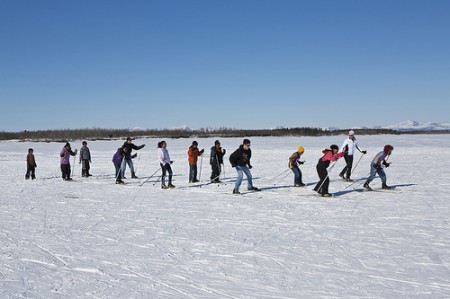
“I had conceived of the Arctic as being a desolate place with villages that were all pretty similar to each other,” he said. “It’s not that simple. The area can certainly be desolate, but at closer examination you realize that the region teams with fish and wildlife and the people who live there have fascinating cultures that are intricately linked to the landscapes and resources that surround them.”
Dunklee was amazed at how the athletes were welcomed into the villages and befriended by family after family. Many were offered a full-access look at what it would be like to live in a village.
“Skiing around the village we saw fresh dead caribou in the back of snow mobile sleds, as well as bear and wolf skins hanging from porches,” she said of her time in Noorvik. “One couple in the village, Dave and Audrey, invited us over to dinner several times. They hunt and gather a lot of their own food, such as caribou, swan, and blueberries… Fresh caribou meat was plentiful but I would crave fruits and veggies if I stayed there long term. The people were super friendly and welcoming- that part would not be hard to get used to.”
Most of the kids in the NANA region will likely stay there. Dunklee said that some might move to Anchorage or other southern parts of the state – a few had already been through the city to visit relatives – but that life outside Alaska itself seemed very foreign to them. Her description of her home state of Vermont was met with mostly blank looks.
But the introduction to skiing may be changing that. For one thing, the vast number of volunteer coaches, many of whom have international racing experience, provided another glimpse of the world to their students. Racing, too, might appear on their radar screen. The kids certainly have the talent.
“I was so amazed at how fast these guys picked it up,” Dougherty said. “In one week, with every day being sub-zero temperatures, I was having to chase down kids that could give the middle school racing scene a run for its money in Anchorage… We had a great coaching staff, and with such an organized program, I wouldn’t be surprised if Alaska starts to see champion skiers coming out of the NANA region in years to come.”
After the recent passing of Canadian champion Shirley Firth and the renewed focus on that country’s now-defunct Territorial Experimental Ski Project, we asked Dougherty if he thought something similar could be put in place in the NANA region. After all, the prospect of moving kids from village to village for ski races is fairly daunting.
But there is a “no road” ski conference a few hundred miles south in a different group of villages, and Dougherty said that Alaska provides other opportunities, too, for kids to start to get involved in racing if they want to.
“The Arctic Winter Games is a sports competition for countries that touch the Arctic Circle,” he explained. “I went for snowshoe biathlon in 2006, and it’s a great way to get international race experience at a young age. The Russians and Norwegians are always very good. Qualifying for Team Alaska is split up by regions of the state, so the bush areas are always represented at these events as well as urban Alaska… I do know that many village kids look at Arctic Winter Games as the highest level of competition. I certainly did when I went as a youngster.”
For Grownups, too
Finally, while NANANordic is undoubtedly focused on the kids, Hall couldn’t deny that it was fun to give another group of athletes the chance to join the NANANordic experience.
“It didn’t take too much arm twisting to get other biathletes involved,” he said. “I’ve always felt that travel is one of the best ways to challenge the assumptions we all carry of places we’re not familiar with and NANANordic is doing a great job of creating what amounts to a cross cultural exchange that benefits everybody involved… I anticipated that the program would have a big impact on each of them and based on the feedback I’ve received so far, it did.”
The athletes weren’t just being nice when they talked to Hall; the experience had made a deep impression on them.
“We spent our time playing games on skis, just delighting in being outside, in being active, and sharing that with other people,” said Susan Dunklee, the top-ranked American woman on last year’s World Cup circuit. “Sometimes in the middle of the race season you can lose sight of what you love about skiing, and this was a great reminder for me.”
The trip wasn’t quite all fun and games; athletes also had the chance to challenge themselves in a way that was every bit as tough as racing, but also completely different. They were offered the opportunity to ski from one village to the next.
“Dylan Watts, Odin Brudie and myself skied 35 miles to Selawik,” Dunklee said. “We carried heavy packs with food, dry clothes and water, plus a rifle for safety. It was cold enough that I wasn’t able to stop moving for more than a couple minutes at a time or my fingers went numb. Going into it, I was very confident in my ability, but it turned out to be surprisingly tough. We skied for 6 hours and I bonked hard the last few miles. I recovered at the end by eating a piece of muktuk [whale blubber].”
Last year, when Hall and Studebaker skid 48 miles from Deering to Buckland, 30 of that over pack ice, they surprised themselves and everyone else.
“Kids in both villages couldn’t believe that it was possible because nobody had ever done it before,” Hall explained. “Trips like that are typically reserved only for airplanes, snow machines and the occasional dogsled. With one long ski we opened their imaginations to how incredible and capable the human body is!”
For Dunklee, who had never been to Alaska even to race, the trip opened up the wonders of the state, too.
“The terrain was mostly flat and treeless with some big hills off to one side,” she said. “Sometimes when the fog lifted we could see the trail stretching out for miles ahead of us. We passed wolf tracks and a herd of caribou.”
It will be a memory to hang onto as athletes hit the roads and trails this month, writing another season of hard training into the books.
Chelsea Little
Chelsea Little is FasterSkier's Editor-At-Large. A former racer at Ford Sayre, Dartmouth College and the Craftsbury Green Racing Project, she is a PhD candidate in aquatic ecology in the @Altermatt_lab at Eawag, the Swiss Federal Institute of Aquatic Science and Technology in Zurich, Switzerland. You can follow her on twitter @ChelskiLittle.



One comment
D. Diehl
May 10, 2013 at 7:33 am
You couldn’t ask for a better ambassador for biathlon. I met Zach Hall on the trails at Mt. Van Hoevenberg in Lake Plaid a few winters ago when he was still competing. What a friendly individual willing to share his time and reflect on biathlon.